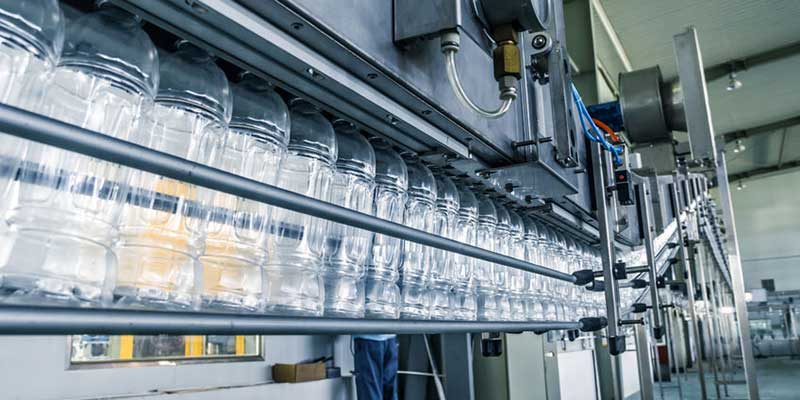Besides the product itself, bottling plants require large amounts of water for manufacturing processes.
Efficiency advances in wastewater reuse and desalination are bringing on-site treatment within reach of more manufacturing operations
Three factors — climate, overuse, and pollution — are now propelling the manufacturing industry toward a sea change in its water use.
Demand for fresh water is high and increasing. The U.S. Census Bureau has estimated that the U.S. manufacturing industry requires 18 billion GPD of water for use in production operations. Manufacturing accounts for almost 25% of global freshwater withdrawals, and by the middle of the 21st century, projected demand is expected to skyrocket.
As demand in the industrial sector grows, global supplies of fresh water continue to dwindle. With ready sources of water less available, alternate water sources such as desalination and wastewater recycling will become more important to manufacturers.
Increasing Water Efficiency
In recent years, significant recent advances in desalination and wastewater treatment for reuse have become much more cost-efficient. With the growing body of best practices and new-generation systems, these alternate sources now offer a clear competitive edge to water-intensive manufacturing operations in many regions. Here are a few examples:
- In the manufacture of microcircuitry and pharmaceuticals, ultrapure water (water purified beyond the quality of municipal water supplies) is required. In parts, building materials, vehicle manufacturing, and aircraft maintenance, cleaning of surfaces is essential, but hard rinse water leaves white or gray calcium or magnesium salt spots that detract from the appearance of surfaces and can harm functionality. In both cases, needs can be met with membrane-based treatments such as reverse osmosis, which have become more economical with introduction of improved membranes.
- Other industries that benefit from these membrane process include food and beverage processing. High volumes of water are bottled for drinking, and used in beer brewing and soft drink production. Beyond requiring potable water, bottlers and other facilities also require pure, salt-free make-up water for their cooling towers and boilers to prevent inefficiency and scale buildup.
- Meat processing, fresh pack, seafood, and processed food manufacturing plants also require high-quality water for edible products. Such operations are often good candidates for waste-to-energy systems that anaerobically digest organic matter in effluent to create biomethane, which can in turn generate heat or electricity to cut energy expenses and limit waste discharge, as well as provide recycled water for plant processes.
- In industrial applications that require salt-free water, RO desalination has undergone a radical reduction in operating expenses. Construction costs alone once made desalination feasible only on a large scale for cities and regions, but new, small- and medium-scale modular desalination systems like the Fluence NIROBOX™ are easily scalable to factories’ needs and lower the total cost of water. These can also be configured to treat the water to many degrees of quality.
High Industrial Water Rates
According to a 2015 Census Bureau report, industrial rates for 10 million gallons of city water, excluding sewage fees, start at a monthly low of $10,053 in Fresno, California, with a median cost of $31,942 in San Antonio, and a high of $82,537 in Atlanta. At these rates, many manufacturing operations could pay off construction costs for suitable RO desalination systems within three years.
Greatly increased on-site water treatment and reuse is expected in the manufacturing industry, starting in water-stressed regions. The municipal and industrial reuse segment climbed to almost $8.9 billion during 2016 and is expected to grow to $14.9 billion in 2021, at a corrected annual growth rate of 10.9%.
In coastal regions with a freshwater shortage and a bounty of saltwater (not just from the ocean, but also from saltwater intrusion into aquifers), the high efficiency and low installation costs of new-generation modular desalination is widening manufacturing’s access to the technology.
Your Business’ Water Needs
How can your business harness new technologies to increase water efficiency? Contact our experts at Fluence to see how water reuse, waste-to-energy, and desalination and other membrane processes can prepare you for an increasingly water-stressed future.

